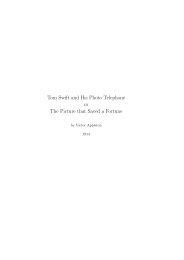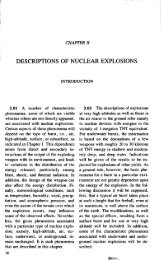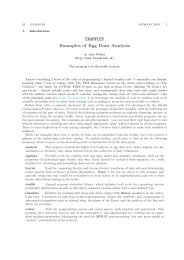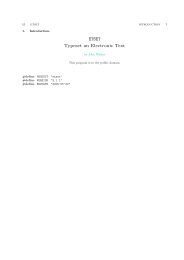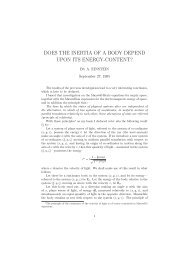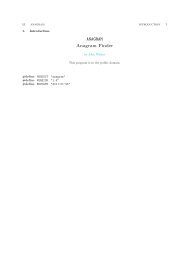The Annoyance Filter.pdf - Fourmilab
The Annoyance Filter.pdf - Fourmilab
The Annoyance Filter.pdf - Fourmilab
Create successful ePaper yourself
Turn your PDF publications into a flip-book with our unique Google optimized e-Paper software.
52 BASE64 MIME DECODER ANNOYANCE-FILTER §52<br />
52. Read the encoded input stream and return the next non-white space character. This code does<br />
not verify whether characters it returns are valid within a base64 stream—that’s up to the caller to<br />
determine once the character is returned.<br />
〈 Get next significant character from input stream 52 〉 ≡<br />
while (true ) {<br />
c = −1;<br />
while (ip < inputLine .length ( )) {<br />
if (inputLine [ip] > ’␣’) {<br />
c = inputLine [ip ++];<br />
break;<br />
}<br />
ip ++;<br />
}<br />
if (c ≥ 0) {<br />
break;<br />
}<br />
if (¬getNextEncodedLine ( )) {<br />
break;<br />
}<br />
}<br />
This code is used in section 51.<br />
53. An end of file indication (due to encountering the MIME part separator sentinel) is valid only after<br />
an even number of four character encoded sequences. Validate this and report any errors accordingly.<br />
If an unexpected end of file is encountered, any incomplete encoded sequence is discarded.<br />
〈 Check for end of file in base64 stream 53 〉 ≡<br />
if (c ≡ EOF) {<br />
if (i > 0) {<br />
nDecodeErrors ++;<br />
mf ⃗ reportParserDiagnostic("Unexpected␣end␣of␣file␣in␣Base64␣decoding.");<br />
}<br />
return −1;<br />
}<br />
This code is used in section 51.<br />
54. Once we’ve decoded four characters from the input stream, we have four six-bit fields in the b<br />
array. Now we extract, shift, and ∨ these fields together to form three 8 bit bytes. One subtlety arises<br />
at the end of file. <strong>The</strong> last one or two characters of an encoded four character field may be replaced by<br />
equal signs to indicate that the final field encodes only one or two source bytes. If this is the case, the<br />
number of bytes placed onto the decodedBytes queue is reduced to the correct value.<br />
〈 Assemble the decoded bits into bytes and place on decoded queue 54 〉 ≡<br />
o[0] = (b[0] ≪ 2) | (b[1] ≫ 4);<br />
o[1] = (b[1] ≪ 4) | (b[2] ≫ 2);<br />
o[2] = (b[2] ≪ 6) | b[3];<br />
j = a[2] ≡ ’=’ ? 1 : (a[3] ≡ ’=’ ? 2 : 3);<br />
for (k = 0; k < j; k++) {<br />
decodedBytes .push back (o[k]);<br />
}<br />
This code is used in section 50.




